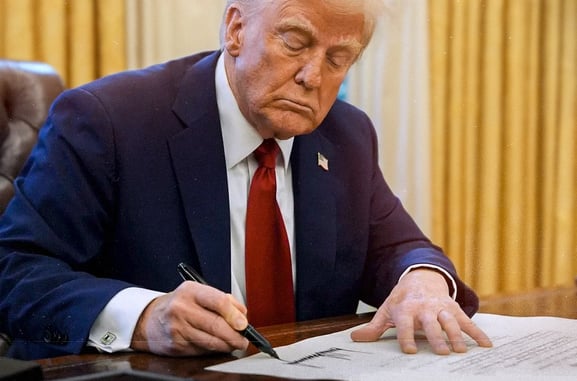
Latest Article: What is a Sovereign Wealth Fund and Why is America Creating One?
What is a Sovereign Wealth Fund and Why is America Creating One?
Trump signed an action to create an American Sovereign Wealth Fund by the end of 2025. What is a SWF and what does this decision mean for the United States?
BUSINESSHOMEPAGE - FEATURES - ROW 1ECONOMY
David Kindness, CPA
2/4/2025



What is a Sovereign Wealth Fund and Why is America Creating One?
Published on February 3, 2025
Written by David Kindness, CPA
Why you can trust Your Creative CPA
Our content is written, edited, or both by industry experts who are creative entrepreneurs just like you. Learn more.
On February 3rd, 2025, President Donald Trump signed an action to create an American sovereign wealth fund by the end of 2025. This represents a significant move that could reshape the U.S. economy in the coming years. This decision has sparked widespread discussion about the role of such funds in national economies and why America, a global economic powerhouse, is now venturing into this territory.
But what exactly is a sovereign wealth fund (SWF) and why is America creating one? In this article, we’ll explain what a sovereign wealth fund is, the motivations behind America’s decision to create one, and the impact it could have on the US and world economies and businesses.
What is a Sovereign Wealth Fund?
A sovereign wealth fund (SWF) is a state-owned investment fund that pools financial assets, such as surplus reserves, natural resource revenues, or foreign exchange reserves, to invest in a variety of assets. These assets can include stocks, bonds, real estate, infrastructure projects, and even private equity. The primary goal of an SWF is to generate long-term returns, stabilize the economy, and provide a financial cushion for future generations.
Sovereign wealth funds are typically created by countries with significant budget surpluses or large reserves of natural resources, such as oil or gas. For example, Norway’s Government Pension Fund Global, funded by oil revenues, is one of the largest and most well-known SWFs in the world. These funds are often seen as tools for economic diversification, wealth preservation, and strategic investment.
Why Does Trump Want to Create a Sovereign Wealth Fund?
While Trump has not released specific details about his goals for a US Sovereign Wealth Fund, he likely has some general goals in mind. Sovereign wealth funds are generally created to fund economic development and infrastructure investments, improve global financial competitiveness, and create of a financial safety net to better weather economic storms.
In the same way that an individual might contribute to an investment account to save up for the future, a country can create a sovereign wealth fund to achieve the same goal. Not only can a country use this fund to achieve its future financial goals, but it can also be used to help preserve wealth and economic prosperity for future generations, limiting the risk of financial collapse.
However, among these larger and more noble goals, Trump hinted that a US Sovereign Wealth Fund could be used to purchase and run TikTok in the US, stating that “we’re going to be doing something perhaps with TikTok, and perhaps not.”
What is the Purpose of a Sovereign Wealth Fund?
Next, let’s explore the purpose of SWFs and what a sovereign wealth fund could mean for America. The creation of a sovereign wealth fund could have far-reaching implications for the U.S. economy and its citizens:
Economic Diversification and Stability: The U.S. economy, while strong, is heavily reliant on sectors like technology, finance, and consumer goods. A sovereign wealth fund could help diversify the nation’s investments, reducing vulnerability to sector-specific downturns, larger recessions, and market crashes.
Infrastructure Development: One of the primary goals of the U.S. sovereign wealth fund is to invest in critical infrastructure projects, such as roads, bridges, and renewable energy initiatives. This aligns with broader efforts to continually modernize the country’s infrastructure, and these infrastructure investments could create millions of jobs, boosting employment and economic growth.
Global Competitiveness: Many countries, including China, Norway, and Saudi Arabia, have used sovereign wealth funds to gain strategic advantages in global markets. By creating its own SWF, the US aims to increase its strategic influence and improve its global influence.
Wealth Generation: Much like how an investment account earns money for an individual, an SWF can earn money for a country by earning a return on invested capital. This could also provide a source of revenue for the federal government and potentially reduce the government’s reliance on taxes or money printing (i.e. inflation).
Wealth Preservation for Future Generations: With rising national debt and economic uncertainty, a sovereign wealth fund could serve as a financial safety net, helping to ensure that future generations benefit from today’s economic prosperity.

A sovereign wealth fund is like an investment account for an entire country. They invest in it, it grows, and they use a portion of the investment to fund national interests.

Potential Pros and Cons of a US Sovereign Wealth Fund
Sovereign wealth funds - whether in the United States or abroad - are not without potential downsides. Below are the pros and cons of a potential American Sovereign Wealth Fund:
Sovereign Wealth Fund Pros
Economic Diversification: The fund could reduce reliance on specific sectors by investing in emerging industries.
Infrastructure Development: Investments in roads, bridges, and renewable energy projects could modernize infrastructure, create jobs, and boost economic growth.
Wealth Preservation: By generating long-term returns, the fund could provide a financial safety net, stabilize the economy during crises, and reduce national debt.
Global Competitiveness: The fund could help the US compete more effectively with other nations that already have SWFs.
Economic Stability: During recessions or market downturns, the fund could inject liquidity, support struggling sectors, and fund stimulus programs.
Social and Environmental Benefits: The fund could address issues like affordable housing, education, and climate resilience, promoting social equity and sustainability.
Greater Global Influence: International investments could strengthen diplomatic ties, counter rival powers, and promote values like democracy and human rights.
Sovereign Wealth Fund Cons
Risk of Mismanagement: Poor investment decisions or lack of transparency could lead to significant financial losses and undermine public trust.
Political Interference: The fund could become a tool for political agendas, leading to inefficient allocation of resources, corruption, or political biases.
Market Distortions: Large-scale investments by the fund could distort markets, potentially crowding out private investors or inflating asset prices.
High Initial Costs: Establishing and capitalizing the fund would require substantial upfront investment, which could strain federal budgets or increase national debt in the short term.
Ethical Concerns: Investments in certain industries or countries could raise ethical questions, such as supporting regimes with poor human rights records or environmentally harmful projects.
Complex Governance: Ensuring effective governance, accountability, and transparency would be challenging, especially given the fund’s potential size and scope.
Uncertain Returns: Like any investment, the fund’s performance would depend on market conditions, and there’s no guarantee of high returns, especially in volatile markets.
Market Distortions: Large-scale investments by the fund could distort markets, potentially crowding out private investors or inflating asset prices.
What Are The World’s Largest Sovereign Wealth Funds?
To understand the potential impact of America’s sovereign wealth fund, it’s helpful to look at some of the largest and most successful SWFs around the world:
Norway Government Pension Fund Global: With over $1.4 trillion in assets, this fund is the largest in the world. It is funded by Norway’s oil revenues and invests globally in stocks, bonds, and real estate.
China Investment Corporation (CIC): Established in 2007, the CIC manages over $1.2 trillion in assets. It focuses on diversifying China’s foreign exchange reserves and investing in global markets.
Abu Dhabi Investment Authority (ADIA): With an estimated $800 billion in assets, ADIA is one of the most influential SWFs in the Middle East. It invests in a wide range of assets, including equities, fixed-income, and alternative investments.
Kuwait Investment Authority (KIA): Founded in 1953, KIA is one of the oldest sovereign wealth funds, with assets exceeding $700 billion. It plays a key role in managing Kuwait’s oil wealth.
Singapore’s GIC: The Government of Singapore Investment Corporation manages over $500 billion in assets and is known for its prudent investment strategies and global reach.
These large, longstanding funds demonstrate the potential of sovereign wealth funds to generate wealth, stabilize economies, and enhance global influence. America’s entry into this space could mark a new chapter in its economic history.
Conclusion
The creation of a sovereign wealth fund in the United States represents a bold move to improve America's economic power and optimize saving, spending, and investing. By diversifying investments, funding critical infrastructure projects, and enhancing global competitiveness, the fund could play a pivotal role in shaping America’s economy for decades to come. While the concept of a sovereign wealth fund is not new, its adoption by the U.S. underscores the evolving nature of global economics and the need for innovative solutions to address complex challenges.
Frequently Asked Questions (FAQs)
What is The Goal of a Sovereign Wealth Fund?
A sovereign wealth fund is designed to manage and invest a nation’s surplus reserves or revenues, such as those from natural resources, to generate long-term returns, stabilize the economy, and provide financial security for future generations.
How Will America’s Sovereign Wealth Fund be Funded?
While specific details are still emerging, America’s sovereign wealth fund is expected to be funded through a combination of taxes, money printing (inflation), federal budget surpluses, revenues from natural resources, and potentially other sources such as domestic or foreign exchange reserves.
What Are The Risks of a Sovereign Wealth Fund?
Like any investment, sovereign wealth funds carry risks, including market volatility, poor investment decisions, and political interference. To mitigate these risks, it is essential to establish strong governance structures and maintain transparency in fund management.
Disclaimer: the information provided in this article is for educational purposes only and does not constitute tax, accounting, investing, legal, or financial advice. The information in this article does not take into account your unique financial or business situation or goals, and YCCPA cannot be responsible for reader's financial decision-making. YCCPA's goal is to educate and support you on your creative business journey.
Written by David Kindness, CPA
David is a CPA (Certified Public Accountant) and professional photographer, videographer, and designer based in San Diego, California. Learn more.




Supported by Ads
Your Creative CPA is supported by the ads you see in our articles and guides.
These ads help us help creatives like you.

financial wisdom for creatives, by creatives
Created by David Kindness
Copyright 2025 Terms






